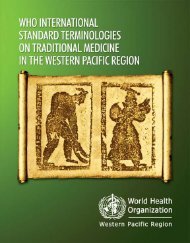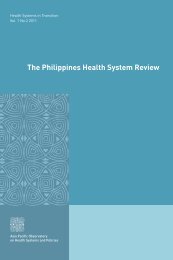Download pdf, 989kb - WHO Western Pacific Region - World Health ...
Download pdf, 989kb - WHO Western Pacific Region - World Health ...
Download pdf, 989kb - WHO Western Pacific Region - World Health ...
You also want an ePaper? Increase the reach of your titles
YUMPU automatically turns print PDFs into web optimized ePapers that Google loves.
A Review of Literature and Projects 2005<br />
(6) Information on interventions,<br />
policies and legislation was<br />
obtained from reports and<br />
papers written by relevant<br />
government agencies, including<br />
the Ministry of <strong>Health</strong>.<br />
3. Key findings<br />
The findings of the review are described<br />
under four main themes: demography;<br />
sexual and reproductive health status;<br />
policies/legislations; and interventions.<br />
3. 1. Demography<br />
Two aspects are presented – general<br />
demography and the age at marriage, the<br />
latter being relevant as a proxy indicator<br />
for sexual and reproductive health<br />
activities and especially for risk of<br />
pregnancy and its consequences for<br />
young females.<br />
3.1.1. General demography<br />
Malaysia comprises thirteen (13) states<br />
and three (3) federal territories in three<br />
regions – Peninsular Malaysia, Sabah and<br />
Sarawak. The country’s population has<br />
more than tripled over the last four<br />
decades and, in 2002, was 24.5 million.<br />
The average annual rate of population<br />
growth is 2.6%. The per capital income<br />
in 2002 was RM13 781 (US$ 3626),<br />
placing Malaysia among middle-income<br />
economies. The health profile of<br />
Malaysia resembles that of a country in<br />
transition from developing to developed<br />
national status.<br />
The demographic profile shows a<br />
relatively “young nation”, with a sizeable<br />
population between the ages of 10 and<br />
24. The population of young people is<br />
shown as a percentage in Figure 1 and in<br />
absolute numbers in Figure 2. While the<br />
percentage has remained almost stable,<br />
the absolute numbers of 0-24 year-olds<br />
have increased over the years.<br />
Young people (15-24 years of age) make<br />
up a fifth of the population, while<br />
younger children (0-14 years of age)<br />
make up about 40%. On a population<br />
pyramid, Malaysia’s population shows<br />
what is often termed a “youth bulge”,<br />
which has clear implications for the social<br />
and economic fabric of the nation,<br />
especially in terms of creating more<br />
demands for specific services for that age<br />
group. This is important since it provides<br />
policy-makers with evidence of the<br />
importance of the health of adolescents,<br />
a group that used to be considered less<br />
important simply because their mortality<br />
and morbidity rates are low. The fact that<br />
they contribute to a sizeable proportion<br />
of the population is enough reason for<br />
attention to be accorded to adolescents.<br />
17

















